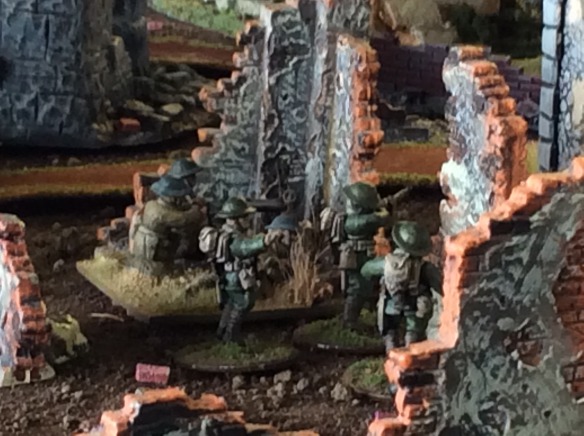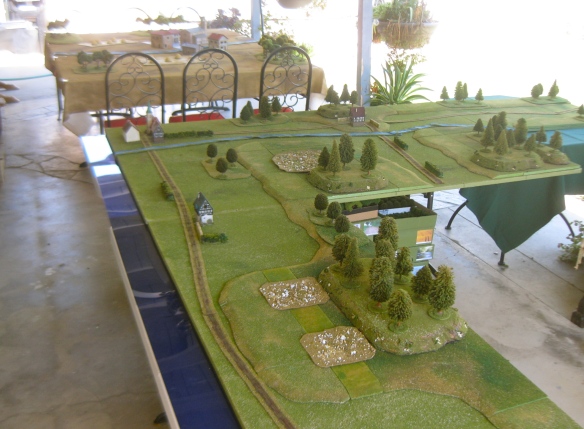As WR works on his upcoming 28mm Clash of Empires Battle of Dara 530 AD report, he found several ten photo files of past late YR2019 and YR2020 games unreported on Wargamerabbit. These ten games were either “pick up scenarios”, test game scenarios, or WR found the photo log too incomplete to write up a full AAR blog article. Most are Flames of War games fought out in Russia, in Italy at Salerno or Anzio, the Ardennes Bulge 1944 period, or even in Greece 1941 with fallschirmjager and EW British/Greeks. Other games include a grand 28mm WWI trench assault/raid game at David’s (fellow gamer), and two more 25/28mm napoleonic Peninsular battles. The scenario results or outcome, if WR remembers are noted, many of these scenario battles lasted to the final turns.
In order of blog article appearance, I list the photo grouping, if you wish to scroll for your favorite gaming era. Most miniatures and terrain from the WR collections unless noted from David, Bruce, or Gary’s collections;
1). Peninsular War 25/28mm Battle of Almonacid 1809
2). F;ames of War (15mm) German Fallschirmjager airborne landing in Greece
3). Flames of War (20mm) Ordeal of the 179th Regiment at Salerno 1943 replay
4). Flames of War (15mm) Panzer Invasion Russia 1941 “Meet the Train: scenario
5). Flames of War (20mm) Operation Fischfang 1943 Anzio scenario
6). Flames of War (20mm) Rail yard raid 1943: Soviet Partizans vs. German rail security
7). Warhammer 1917 “Over the Top” 28mm Trench raid/assault scenario (at David’s)
8). Peninsular War 25/28mm Battle of Vimeiro 1808 test game
9). Flames of War (20mm) Bulge 1944 with Pz Brigade 150 with support vs. Americans
10). Flames of War (15mm) Bulge 1944. German Panzers vs. 99th American Division
First up: The Battle of Almonacid 1809 fought between the French and Spanish armies south of Madrid. French advanced from Madrid to confront the Spanish nearing the capital city. This scenario ran true to history with minor adjustment for the scenario notes. WR expects this scenario will become a full AAR scenario post this year.

Almonacid 1809 battlefield looks empty except for formation wooden blocks. These wooden green block saves lots of actual miniature movement till commands approach. Also great fog of war situation too.

When the commands reach deployment range, the 25/28mm napoleonic miniatures are deployed to the tabletop. Here the Spanish on left, the French on the right side of photo.

View from the opposite table end. The French flanking commands are pushing back the Spanish left flank. Castle hill upper right with nearby Almonacid village.

French cavalry charging in to repulse the Spanish weak cavalry attack. Miniature ratio 90:1 or 90 soldiers represents one miniature. Battalions of Infantry, cavalry regiments, or battery.

Later on the Spanish left retired to the nearby orchard. French, Poles, and the German division battalions seek them out.

French infantry battalions pressure the Spanish before Almonacid village and Castle hill. The hill was a linchpin for the Spanish late game defense. The “Yellow” order marker beneath the officer.

A fresh French division arrives marching up the roadway towards Almonacid. French for the win in this test scenario.
Second: FOW German Fallschirmjager landing in Greece 1941. This was WR’s first FOW scenario or game using German glider models. Scenario had German Fallschirmjager land by glider or chutes on the double tabletop. Defending a Greek port was British infantry company and inland, a Greek infantry company. WR”s air-landing company took the village after hard door to door battles but the Greeks totally owned the Fallschirmjager who landed by their chutes. Miniatures and terrain for this scenario from Bruce and Gary’s FOW 15mm collections. Continue reading



























